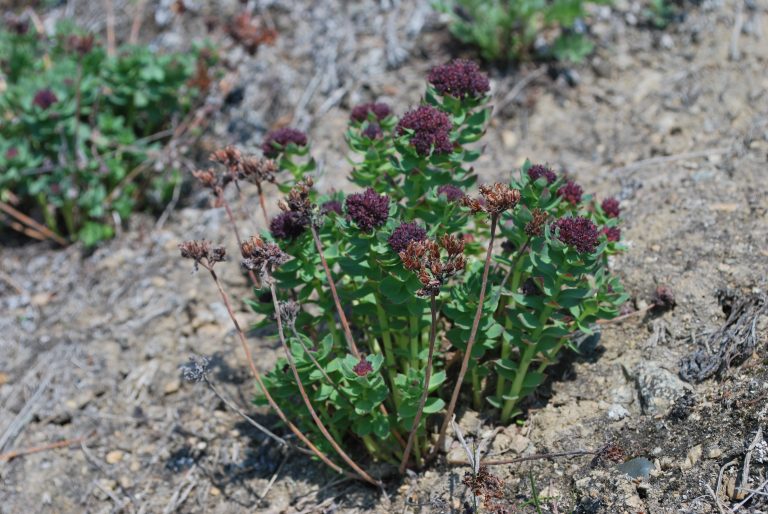Chukchi: юңъэв (yung’ev)
Naukan: сақлъак (saqlak)
Central Alaskan Yup’ik: caqlak (Hooper Bay, Chevak, Scammon Bay)
Russian: родиола розовая (rodiola rosovaya)
English: rose root
Naukan:
In Naukan, people picked this in rocky areas, near stream banks. The tender stems and leaves are harvested in June and July, before they flower. They are cut into small pieces, mashed up and left to ferment in their own juices until it was ready to freeze for the winter. The resulting dish, called quvieggkarak, turned out like saurkraut. Traditionally, they were stored in barrels, and people put a rock on top to keep the leaves below the surface of the juice. Sometimes the top layer would go bad, so they had to remove it and throw it away before the weather got cold. Nowadays, some people store these in freezer, but it doesn’t turn out as sour. People eat this during the winter with sea mammal fat or dry or frozen meat, or with sugar sprinkled on them. Later, Naukan people learned from Russians that the root can also be gathered and put in alcohol to make a general tonic.
Науканцы:
Наукане родиолу собирали в каменистых местах, у берегов ручьев. Нежные стебли и листики собирают в июне и июле до цветения. Их мелко нарезают, разминают и оставляют ферментироваться в собственном соку, пока они не будут готовы к заморозке на зиму. Получаемое блюдо, которое называют к’увьех’к’арак’, получается похоже на квашеную капусту. Традиционно заготовки хранят в бочках, и сверху на них кладут камень, чтобы листья погружались в сок. Иногда верхний слой портится, и его нужно убирать и выкидывать, пока не похолодает. В наши дни некоторые так же хранят их в морозильнике, но оно не получается таким же кислым. Его едят зимой с жиром морских млекопитающих или с сушеным или мороженым мясом. Его также можно есть посыпав сахаром. Позже науканцы узнали у русских, что корень также можно собирать и настаивать на водке чтобы сделать общеукрепляющее средство, однако сами они им не пользовались
Chukchi:
The young leaves and stems are gathered to ferment and eat later with meat. Some people say the young flowers can also be gathered, before they become hard. Other plants such as sourdock (Rumex arcticus), wild onion (Allium shoenprasum) and others are sometimes added while fermenting. In former times, people would ferment them in seal pokes. Now they use barrels or other containers. They are eaten later with sea mammal fat or with sugar.
Some people gather the roots in September or October and make a tincture with alcohol as a general tonic. In the old days, people did not make medicine from this plant. Currently, some Chukchi only make this to give or sell to Russians, but others have started to use it too.
Чукчи:
Молодые листья и стебли родиолы ферментируют и едят с мясом. Некоторые говорят, что собирать также можно молодые цветы, пока растение не «задеревенело». При ферментации иногда добавляют другие растения, такие как щавель (Rumex arcticus), дикий лук (Allium shoenprasum) и другие. В прежние времена их ферментировали в пыгпыге (нерпичьей шкуре, снятой чулком). Теперь для этого используют бочки или другие емкости. Родиолу затем едят с жиром морских животных или с сахаром.
Некоторые собирают корни родиолы в сентябре или октябре и делают настойку на водке в качестве общеукрепляющего. Раньше это растение не использовали в лекарственных целях. Теперь же настойку делают, чтобы продать или отдать русским, но некоторые также начали использовать ее сами.
Central Alaskan Yup’ik:
The root is the only part gathered in coastal villages such as Hooper Bay ad Scammon Bay. It is chewed and put directly on sores. Elders also said people bite on it where they have a toothache to help the pain.



